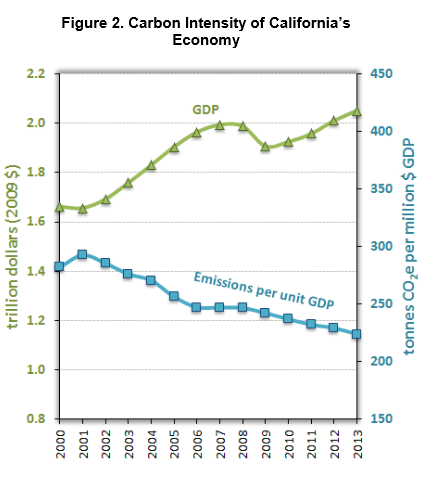With the eyes of the world on the climate negotiations in Paris, world leaders can learn much from California’s recent experience. There are at least three lessons from the Golden State that can help shape global efforts to confront climate disruption while advancing economic and social justice.
- Enforceable standards are vital to reducing emissions
California has often led the way in adopting rules that spur innovation in clean energy and transportation. California’s Renewables Portfolio Standard (RPS), first adopted in 2002, has led to a ramp up in the production of electricity from renewable resources such as solar, wind, and geothermal. Currently, California’s RPS is at 33% by 2020, with a longer-term goal of 50% by 2030. California was the first state in the nation to adopt an RPS, and similar clean energy mandates now exist in a total of 29 states and the District of Columbia with another 7 states having non-binding clean energy goals.[1]
California’s clean-car standards, such as the Zero Emission Vehicle (ZEV) mandate, are responsible for helping increase the number of advanced clean cars on the road in the Golden State. About half of all plug-in electric (PEV) vehicles in the U.S. are sold in California, which has the highest concentration of electric vehicles nationwide.[2]
Nine other states – accounting for one-fourth of the light-duty vehicle market in the U.S., including California – have adopted a similar ZEV standard.[3]
ZEVs and near-zero emission vehicles save consumers money on fuel and maintenance costs, in addition to polluting less than conventional vehicles.
Source: California Air Resources Board[4]
- Leading with equity is important and makes greater emission reductions possible.
California law (SB 535, De León, 2012) requires that some of the revenues raised by charges on polluters go to reduce pollution in the communities that have historically suffered from environmental injustice. These low-income communities of color have been the strongest supporters of taking bold action to combat climate change, and they now benefit from investments in solar energy, weatherization, public transit, affordable housing, cleaner vehicles and urban forestry. Please check out the UpLiftCA.org blog to hear directly from Californians in disadvantaged communities – i.e., areas with a high level of environmental stress and low socio-economic status – about the effects of pollution and poverty on their lives, and stories of individuals and families benefiting from the transition to a clean energy economy.
Another prime example of California law pursuing climate justice – i.e., integrating environmental justice into climate protection policies or projects – is the Charge Ahead California Initiative (SB 1275, De León, 2014). This bill directs California state agencies to ensure that disadvantaged communities and low- and moderate-income consumers have increased access to zero-emission and near-zero-emission vehicles through public programs aimed at achieving the state’s goal of one million advanced clean cars on the road by 2023. One of the main drivers for this law is the fact that California leads the country in the share of its population living close enough to busy roads and freeways to face increased risk of asthma, cancers, and other health hazards from vehicular pollution.
Globally, leading with equity means that the wealthier countries must assist developing countries to grow sustainably so they can raise their standards of living without the fossil-fuel pollution that accompanied industrial growth in the nations that have accounted for most carbon emissions historically.
- Protecting the planet and growing the economy can go hand in hand.
California’s economy and population have grown over the past decade while global warming pollution has declined, defying the prophecies of the doom-sayers who loudly proclaimed that reducing emissions would damage our economy. The carbon intensity of California’s economy – i.e., tons of missions per million dollars of Gross Domestic Product (GDP) – has fallen over the past decade, which means less pollution from every dollar of economic activity. Indeed, clean-energy policies have drawn innovation and investment to California. If carried out carefully and equitably, policies that reduce pollution of our air and atmosphere can help other states and countries to grow sustainably.

Source: California Air Resources Board[5]
[share title=”Share This Post”]
Lawrence Berkeley National Laboratory. 2013. Renewables Portfolio Standards in the United States: A Status Update. Retrieved December 4, 2015 (http://www.nrel.gov/tech_deployment/state_local_governments/basics_portfolio_standards.html).
U.S. Energy Information Administration. 2014. “California leads the nation in the adoption of electric vehicles.” Retrieved December 4, 2015 (http://www.eia.gov/todayinenergy/detail.cfm?id=19131).
Ibid.
California Air Resources Board. 2015. “California Greenhouse Gas Emissions for 2000 to 2013 – Trends of Emissions and Other Indicators.” Retrieved December 4, 2015 (http://www.arb.ca.gov/cc/inventory/data/data.htm).
California Air Resources Board. 2015. “California Greenhouse Gas Emissions for 2000 to 2013 – Trends of Emissions and Other Indicators.” Retrieved December 4, 2015 (http://www.arb.ca.gov/cc/inventory/data/data.htm).









